
Exploring the Use of Cyanide in Gold Extraction Processes and Its Environmental Impact
The Use of Cyanide to Extract Gold A Double-Edged Sword
Gold has been a precious metal sought after for centuries, valued not only for its beauty but also for its investment potential. The modern methods of gold extraction have further intensified the quest for this elusive metal, with cyanide leaching emerging as a predominant technique in the mining industry. While effective, the use of cyanide poses significant environmental challenges and ethical considerations.
The Use of Cyanide to Extract Gold A Double-Edged Sword
The efficiency of cyanide in gold extraction is indisputable. It allows for the recovery of more gold than traditional methods, such as gravity separation or mercury amalgamation. Moreover, cyanide leaching can be conducted on low-grade ores that would otherwise be uneconomical to mine. This has led to a surge in gold production worldwide, meeting the increasing demand for this precious metal.
cyanide to extract gold

However, the benefits of cyanide usage are overshadowed by its inherent dangers. Cyanide is not only deadly to humans but also poses a severe risk to wildlife and ecosystems. The accidental release of cyanide into water sources can lead to catastrophic environmental accidents, as witnessed in events like the Baia Mare gold mine spill in Romania in 2000, which resulted in widespread ecological damage.
The risk of cyanide exposure has prompted stringent regulations in many countries, yet the effectiveness of enforcement varies. In some regions, particularly where mining operations are less regulated, the potential for contamination remains a great concern. The challenge lies in balancing the economic benefits of gold extraction with the imperative of safeguarding environmental health.
In recent years, the mining industry has seen increased pressure from environmental groups, local communities, and shareholders calling for more sustainable practices. Innovations in gold extraction technologies are emerging as viable alternatives to cyanide use. Processes such as bioleaching, where microorganisms are used to extract gold from ore, are being researched as safer methods. Additionally, some companies are exploring non-toxic alternatives to cyanide, striving to minimize the environmental impact while still achieving efficient gold recovery.
In conclusion, while cyanide has been instrumental in the modern gold mining industry, its usage raises significant ethical and environmental concerns. As the demand for gold continues, the industry faces an urgent need to adopt safer practices. The future of gold extraction may lie in a combination of innovative technologies and a commitment to sustainable mining practices. By reassessing the reliance on cyanide and investing in alternatives, the gold industry can work toward a more responsible and environmentally-conscious future, ensuring that the lust for gold does not come at the expense of the planet's health and the well-being of its inhabitants.
-
The Safety Challenges of Ammonium Nitrate FertilizerNewsJun.26,2025
-
The Critical Role of Mining ChemicalsNewsJun.26,2025
-
Shelf Life of Glacial Acetic Acid Food GradeNewsJun.26,2025
-
Enhancing PVC Longevity with 1,2,3-Benzotriazole InnovationsNewsJun.26,2025
-
China’s Dominance in Food Additive ProductionNewsJun.26,2025
-
Can Aluminum Hydroxide Replace More Toxic Alternatives?NewsJun.26,2025
-
PE and PP Plastics with Benzotriazole AdditivesNewsJun.12,2025
Hebei Tenger Chemical Technology Co., Ltd. focuses on the chemical industry and is committed to the export service of chemical raw materials.
-

view more DiethanolisopropanolamineIn the ever-growing field of chemical solutions, diethanolisopropanolamine (DEIPA) stands out as a versatile and important compound. Due to its unique chemical structure and properties, DEIPA is of interest to various industries including construction, personal care, and agriculture. -

view more TriisopropanolamineTriisopropanolamine (TIPA) alkanol amine substance, is a kind of alcohol amine compound with amino and alcohol hydroxyl, and because of its molecules contains both amino and hydroxyl. -

view more Tetramethyl Thiuram DisulfideTetramethyl thiuram disulfide, also known as TMTD, is a white to light-yellow powder with a distinct sulfur-like odor. It is soluble in organic solvents such as benzene, acetone, and ethyl acetate, making it highly versatile for use in different formulations. TMTD is known for its excellent vulcanization acceleration properties, which makes it a key ingredient in the production of rubber products. Additionally, it acts as an effective fungicide and bactericide, making it valuable in agricultural applications. Its high purity and stability ensure consistent performance, making it a preferred choice for manufacturers across various industries.











